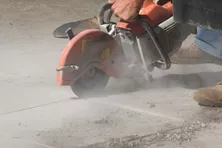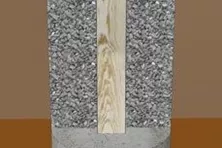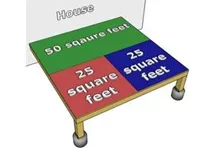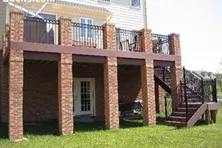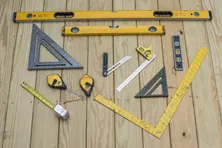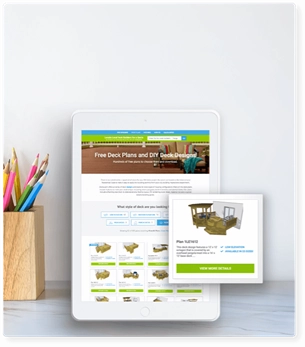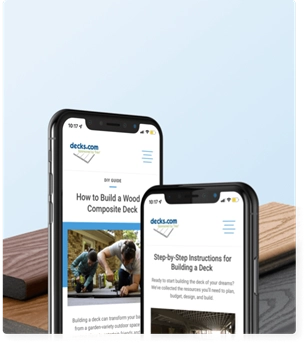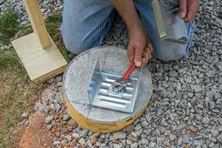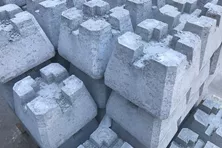Concrete Deck Footing
This footing type uses a concrete pier that extends from the footing base to above grade. There are several variations of this footing type that are commonly used.
Small diameter footings may use a cardboard form tube that is set to the acceptable depth and filled with concrete to produce a monolithic footing.
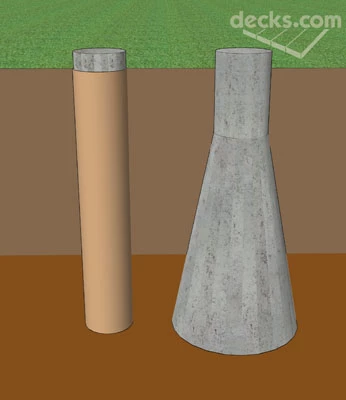
For larger diameter footings, it is more practical to pour a footing base to the appropriate size and depth and extend the footing to the surface with a smaller diameter pier. In order to sufficiently connect the footing to the pier, you will want to use two L-shaped pieces of rebar.
The top of the pier will need to be fitted with a concrete anchor and post base connector in order to accept the deck post. There are different kinds of concrete anchors to choose from that can be installed. Some anchors are set while the concrete is still wet; others are predrilled and then tightened with a wrench to expand into the hardened concrete. Post bases are designed to lock into the concrete anchors and connect to the support posts. The anchor, post base and support post will have to come together in a relatively small area. Using an adjustable post base can give you a little more room to work with.
Footings that use concrete piers offer several advantages over other methods. Once the footings are in place, they will provide permanent visible evidence of the support strength of the structure. Also, this type of footing makes it much easier to replace a post if one ever becomes damaged. You can modify this type of footing by using a rigid plastic base form that is engineered to create a flared base to help prevent frost heaving.
Square footings offer the benefit of maximizing the surface area for soil compression. This variation typically makes more sense where shallow footings are required because hand digging will be required.
Cutting a Concrete Pad
Learn how to use a concrete saw to cut a hole in a patio slab to install a deck footing.
Buried Post
Learn how to install a concrete deck footing with a buried treated support post as an alternative to a solid pier foundation.
Footing Size
Learn how large to make your deck footings. Use our table for maximum allowable loads to determine the proper size for your soil type.
How to Decorate Deck Support Columns
Browse some examples of decorative deck support posts for tall decks.
Deck building tools
As with any professional job, having the right tools can make all the difference.
Engineered Deck Beam
Use treated engineered deck beams for long spans with fewer posts and footings. Engineered beams can be designed and specially ordered from your lumberyard.
More Helpful Resources
Explore Articles by Topic

Footings
Information related to installing frost footings for decks

Framing
Learn structural framing methods

Decking
Learn about wood and composite decking materials

Stairs
An in-depth look at the complex issue of how to build stairs

Railings
How to install guardrails and handrails to meet IRC code

Features
An overview on water drainage, benches, planters and lights

Design
The basics of deck design

Planning
Learn about permits and working with contractors

Porches & Patios
Build a covered deck to enjoy all seasons

Ledger
Proper attachment techniques

Care
Maintain your deck to maintain your investment

Materials
An overview on water drainage, benches, planters and lights
How many footings do I need?
Learn how to determine the number of footings and support posts you need for your deck when designing your deck frame.
Can I reuse existing footings
Our inspector discusses the topic of reusing footings for a new deck.
Can I use pier blocks?
Our inspector explains the pros and cons of using pier blocks for deck foundations.
Why is Joist Protection so Important for Your Deck?
If you’ve ever seen a piece of wood left out in the weather for any period of time, you know what happens: decay. Whether through wet rot, insect damage, or mildew, the fibers begin to break down.
How to Create Strong Post-to-Beam Connections
Learn how to create a positive structural connection for your post to beam connections. Use lag bolts, through bolts with washers, support cleats and hardware connectors.
Deck Joist Cantilever & Overhang Rules
Learn what factors determine the maximum joist cantilever overhang that is allowed.
Explore Articles by Topic

Footings
Information related to installing frost footings for decks

Framing
Learn structural framing methods

Decking
Learn about wood and composite decking materials

Stairs
An in-depth look at the complex issue of how to build stairs

Railings
How to install guardrails and handrails to meet IRC code

Features
An overview on water drainage, benches, planters and lights

Design
The basics of deck design

Planning
Learn about permits and working with contractors

Porches & Patios
Build a covered deck to enjoy all seasons

Ledger
Proper attachment techniques

Care
Maintain your deck to maintain your investment

Materials
An overview on water drainage, benches, planters and lights




